Article by Wayne Gillam, photos by Ryan Hoover | UW ECE News
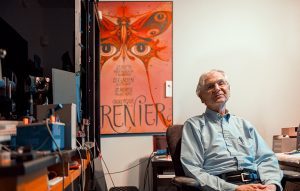
UW ECE affiliate professor and alumnus Gary D. Bernard has had a long, successful engineering career in academia and industry. He has also produced an impressive amount of research exploring how butterflies view and adapt to their environment. Above, Bernard at his home laboratory in Federal Way, Washington.
UW ECE affiliate professor and alumnus Gary D. Bernard (BSEE ‘59, MSEE ‘60, Ph.D. ‘64) has had a long and varied engineering career, one that has been full of unexpected twists and turns. Over the years, it was his ability to seek out and embrace unique connections and opportunities, along with a knack for collaborating with people from diverse backgrounds, that has produced a long, successful, and satisfying professional life. And retiring from Boeing in 2007 hasn’t slowed him down, in fact, he has remained incredibly prolific, producing an impressive amount of research related to how insects, and butterflies in particular, see and understand the world.
In 2023, with a deep love for his research subject fueling him and a recent paper published in the Journal of Experimental Biology, Bernard, 85, is still going strong and is full of excitement about what he and his collaborators might learn and discover next.
“After my postdoc, I was an engineer that wanted to take principles from life sciences and apply them in a technological way to making devices,” Bernard said. “But later, I became more interested in what insects actually do and how they do it. How does a small butterfly eye behave so beautifully and do such amazing things? You can’t imagine what flying insects can do and how capable they are. So, I became much more interested in that, and I still am. But the technological fallout from our work has been absolutely amazing.”
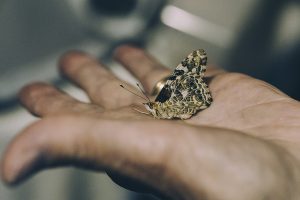
Bernard holding a Painted Lady butterfly that was raised for scientific research. Its wings are waxed prior to a microscopic eye exam with incident white light. The color of reflected light from the butterfly’s eye is a measure of the quantity of visual pigment (rhodopsin) it contains, and among other things, it reveals the health of the eye.
The impact from Bernard’s research has been broad and wide ranging. For example, he has applied fundamental principles learned from his studies of insect vision to improving machine vision and real-time monitoring of manufacturing processes at Boeing. And together with UW ECE Professor Les Atlas and his students, Bernard applied neural network technology to the real-time monitoring of hard-metal machining, work that was later supported by the Office of Naval Research. Bernard has also collaborated and co-authored a paper on Saharan silver ants with a professor of applied physics at Columbia University and a professor of zoology at the University of Zurich to better understand how desert ants are able to survive extreme midday heat. This paper has been widely cited by many groups applying its principles to create materials with optical and thermal radiative properties for passive cooling of diverse objects such as buildings, vehicles, clothing, and even microcircuits. The graduate students Bernard has taught and advised over the years have gone on to make their marks in the field as well. For example, Mandyam Srinivasan, who was Bernard’s doctoral student at Yale University, focused his research on the flight of the worker honeybee. Srinivasan discovered principles of this insect’s flight control that were later applied by the Australian Air Force to ground-following flight control of helicopters and other low-flying aircraft.
Today, as a UW ECE affiliate professor, Bernard continues his research on intracellular optical physiology, rhodopsin photochemistry, and retinal densitometry in the compound eyes of living butterflies. To that end, he conducts experiments and takes measurements of the spectral and polarization properties of these flying insects’ unique and fascinating eyes.
Flying full circle — from UW ECE to MIT, Yale and back again
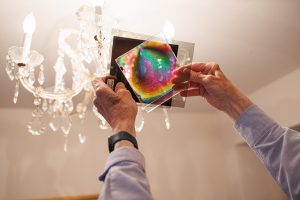
Many butterfly species can see polarized light — light oscillating in only one planar direction. Bernard and his colleagues have recently discovered that some species, such as the Australian imperial blue butterfly, can use visual information gathered from polarized light to detect and assess the health of each other and choose mates. Here, Bernard demonstrates a phenomenon of polarized light, “birefringent interference,” which he uses in his butterfly eye research.
In 1959, Bernard received his bachelor’s degree from UW ECE. He then went on to earn his master’s and doctoral degrees from the Department in 1960 and 1964, respectively. As a graduate student in the early 1960s, Bernard was one of the first to be advised by Professor Akira Ishimaru, who was the Department’s first doctoral degree recipient and one of the world’s top experts in the study of electromagnetic wave propagation and scattering. Ishimaru has since received numerous awards and honors for his work and today is a UW ECE Professor Emeritus.
Under Ishimaru, Bernard focused his doctoral research on frequency-independent guided and radiated electromagnetic waves. He also taught undergraduate courses on transmission lines, pulse circuits, and electronic circuits. According to Bernard, his first love was theoretical work, but Ishimaru insisted that he conduct experiments as well, so Bernard worked on two research contracts and had a Boeing fellowship during this time. He also tested the frequency-independent surface-mounted antennas he designed on a Boeing antenna range.
Bernard said that skills he gained at UW ECE included analysis, useful mathematics, and being able to test things and understand phenomena from both a theoretical and a physical standpoint. He also learned how to collaborate on research and work well with people in teams, which was a skill he believes was crucial to success in both his career and insect research.
“Butterfly vision is so complicated that there is no way you can master all the techniques for studying it. Teaming is necessary,” Bernard said. “By working together, you can accomplish things that no one person could do by themselves. This type of collaboration has happened often in my career, and I have Ishimaru to thank for helping me to build my skills for that.”
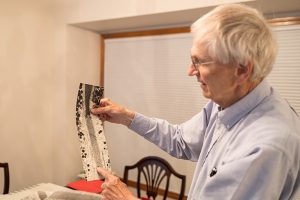
Bernard is holding Yale physiologist William Miller’s electron micrograph, which shows the fine structure of a birefringent photoreceptor waveguide inside a butterfly eye. Bernard exploits the phenomenon of birefringent depolarization to determine the degree of alignment or misalignment of the photoreceptor waveguides of the neighboring “little eyes” that make up the butterfly’s compound eye. Each butterfly compound eye contains thousands of these little eyes, which enable butterflies to see many different things in multiple directions, all at the same time.
In the late 1950s and early 60s, Professor Walter Rogers taught the Department’s undergraduate course in electromagnetic fields and waves, and he pointed Bernard toward this subject for further study. Later, while considering what to do after receiving his doctoral degree, Rogers told Bernard about a new Ford Foundation postdoctoral program at MIT. Bernard applied, and in 1965, he moved to the East Coast to join MIT as a postdoctoral scholar. The Ford Foundation recognized that new engineering postdocs were not necessarily equipped for teaching, so Bernard spent half of his working hours team-teaching electromagnetic theory and the other half on electron-beam and plasma experiments.
About a year after joining MIT, Bernard received a phone call from William Miller, a physiologist at Yale, who was looking for an expert in electromagnetic fields, waves and antenna design. Miller was conducting experiments to better understand insect vision, specifically, how moth eyes adapted to different lighting conditions, such as between day and night. Miller discovered an array of tiny bumps on moth eye lenses and thought that they might be optical dielectric rod antennas. He asked Bernard to theoretically model how these structures interacted with light.
“Bill was examining an electron microscope picture of a moth eye lens, and he noticed that the surface of the lens wasn’t smooth as expected,” Bernard said. “He discovered the lens was covered with 2,000-angstrom hexagonally-packed nipples that functioned as a broadband reflection coating. He also showed me electron microscope images of other structures, such as dielectric waveguides. Well, I just got hooked! So, I started working with him.”
Bernard was “bitten by the bug” of studying insect vision, so much so that he dove headfirst into the field, and, in 1966, he made a notable scientific discovery. While in the process of examining moths and other insects with a microscope loaned by Miller, Bernard caught a butterfly and placed it under the microscope. What he saw through the lens was a small, green reflection from the butterfly eye, but that reflection disappeared before he could photograph it. The next time he looked, it mysteriously changed from green to red. Tests by Miller under an electron microscope confirmed that Bernard had discovered butterfly eyeshine, a phenomenon caused by a reflector behind the retina that makes the eye more sensitive. Eyeshine is most often found in nocturnal animals, and it can often be seen in the eyes of deer or raccoons caught in the glare of an oncoming car’s headlights. Why butterflies, who are only active during the day, have eyeshine is still an open question, but this discovery prompted Bernard to think that light could perhaps be used as an optical probe to learn what butterflies can see. He found this idea exciting, and it set him on the research path he still follows today.
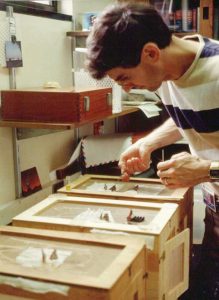
Bernard feeding Vanessa butterflies in his Yale laboratory, 1987. Photo courtesy of Gary Bernard.
In 1968, Bernard joined Yale as an assistant professor with an interdisciplinary appointment that spanned the ophthalmology and visual science department as well as the engineering and applied science department. He also received a five-year research career development award and a grant from the National Eye Institute. His work at Yale focused on the optical physiology and photochemistry of insect visual sensors and, later in his career, on the evolutionary ecology of butterfly color vision. This appointment lasted quite a bit longer than Bernard had expected.
“I thought I would go to Yale for five years, learn some biology and then move on,” Bernard said. “I ended up staying for 21 years. My wife and I had four kids during that time and raised our family in Hamden, Connecticut.”
At Yale, Bernard continued his work with Miller, using electromagnetic waves to study insect vision. He also taught and lectured on a wide range of topics. In his role as an assistant professor in the medical school, he lectured to residents on principles of color vision, physiological optics, corneal and lens transparency, photoreceptor waveguide optics, principles and practice of optical microscopy, use of polarization to reduce glare in ophthalmoscopy and the use of color-contrast filters in ophthalmoscopy. In the biology department, he lectured and gave seminars and tutorials to graduate students on the optics of compound eyes, the principles and practice of optical microscopy, optical physiology, retinal densitometry, and the use of laboratory computers. And in the engineering and applied sciences department, he taught a graduate-level course on electromagnetic theory and undergraduate courses on the application of engineering to living systems. While at Yale, he advised graduate and doctoral students, some of whom went on to make significant impacts in their respective fields.
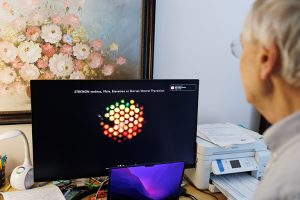
Shown on the computer screen above is one of a series of depolarized butterfly eyeshine photos, taken from the completely intact eye of a living Hairstreak butterfly. Bernard examines facets of different areas of the eye, which enables him to learn how arrays of photoreceptors within the butterfly’s compound eye are organized for competing requirements of motion detection and polarization vision.
Bernard and his wife both were from the Puget Sound area, so in 1989, after their children were grown, they decided to move back to Seattle. Bernard secured a position at Boeing as an engineer in the company’s commercial airplanes’ advanced sensors and machining research and development groups. He also accepted a concurrent appointment at UW ECE, then UW EE, as an affiliate faculty member. This allowed him to move his lab equipment, which could not be transferred to a private company like Boeing, from Yale to the UW.
At Boeing, Bernard looked for innovative ways to detect wear and tear on industrial cutting tools used to machine airplane parts from hard metals. One of his ideas was to apply speech recognition technology to real-time monitoring of manufacturing equipment. This idea sparked a Boeing research contract with the UW and Professor Atlas, whose graduate students Bernard co-advised as a UW graduate faculty member. Later, when this work was funded by the Office of Naval Research, UW ECE Professor Mari Ostendorf also became involved, developing an important method for predicting the remaining life of the monitored cutter.
Bernard worked at Boeing for 18 years, and from 1998 to 2007, he served as the Boeing collaborator with the UW, the University of Maryland, Boston University and the University of Zurich on a multi-university initiative funded by the Office of Naval Research. Bernard’s birth-to-death machining cutter dataset was used by this collaboration to develop and evaluate new methods for real-time monitoring of dynamic faults in machining spindles and cutters. The partnership also established the Center for Acoustic and Auditory Research at the UW. During this collaboration and all his time at Boeing, Bernard continued his butterfly research after hours.
“Gary was a tremendous collaborator and point of contact for me and my students. He also remained passionate about studying butterflies and insects,” Atlas said. “I remember some scientific meetings where Gary came early to wander off outside with his butterfly net in hand.”
Looking ahead
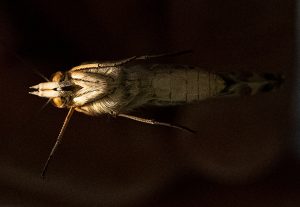
A Painted Lady butterfly held under a microscope with tweezers. This photo shows the insect’s compound eyes, which Bernard studies in his research.
Bernard retired from Boeing in 2007, but he continues to hold his UW ECE affiliate faculty appointment to this day. After retiring, Bernard arranged to transfer his UW equipment to a laboratory he set up in his home in Federal Way, Washington. He has since been collaborating with colleagues at the University of California, Irvine; Harvard University; Columbia University; and Lund University in Sweden on the visual ecology and evolution of butterfly vision. More specifically, Bernard is studying the relationship of butterfly eye design as it relates to the colorful patterns found on butterfly wings and host plants.
Human eyes have three photoreceptor types for color vision, but butterflies, like many other insects and birds, have four or more types of photoreceptors. This enables them to see a much wider spectrum of light in greater detail than humans can. Many butterfly species can also see polarized light — light oscillating in only one planar direction. What Bernard and his colleagues have recently discovered is that some species, such as the Australian imperial blue butterfly, can use visual information gathered from polarized light to detect and assess the health of each other and choose mates. This ability to see polarized light, along with a capacity to see into the ultraviolet and far-red bands of the visual spectrum through compound eyes, which are made up of thousands of tiny lenses, provides these small insects with high visual acuity at close range. It endows them with an awareness of the world that is well beyond what human beings are capable of seeing.
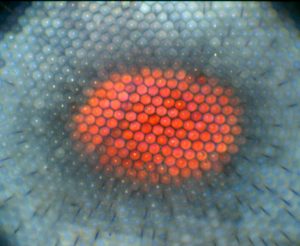
A flash microscopic image of eyeshine taken of a fully dark-adapted Vanessa butterfly eye. The orange facets are the patch of the eye that sees into the 21-degree cone of light that the microscope shines onto the eye. Photo by Gary Bernard.
“The photoreceptor waveguides in butterflies are composed of many tiny, parallel tubes of membrane, packed with molecules of visual pigment, but because of that linear structure, they are more sensitive to polarized light that is parallel to the tubes, than light that is perpendicular. That is the basis for their polarization sensitivity,” Bernard said. “So, what I’m working on now is how they manage the alignment of neighboring units of the compound eye for polarization detection in a way that allows them to still do flight control and image processing that is not disturbed by polarization.”
He already has lined up partnerships to further investigate this topic with leading experts on insect vision and intracellular physiology in Europe and Australia, where a few months from now, he plans to participate in a field research study via Zoom.
Bernard credits the UW for laying the foundation of his long, successful and interesting career. And when asked what he thought about his many years spent at UW ECE, both as a student and later as a faculty member, he had many complimentary things to say.
“When I was a student, I didn’t really understand until much later in my career just how very good our faculty, such as Rogers and Ishimaru, are. Since then, I’ve been at MIT, Harvard, Yale, Princeton, and worked with faculty and students all around the world,” Bernard said. “Looking back at my education, I realized that the quality of both students and faculty at UW ECE is second to none. And the quality of education in the Department compared to what I’ve seen at other universities throughout the years? It’s absolutely top-notch. I was so fortunate to have started my professional life here.”
Read Professor Bernard’s latest research paper, “A hypothesis for robust polarization vision: an example from the Australian imperial blue butterfly, Jalmenus evagoras” in the Journal of Experimental Biology.

